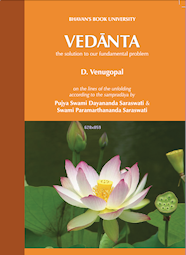
VEDĀNTA the solution to our fundamental problem by D. Venugopal
Part 58 continues the detailed explanation of the process of shravaNa, manana and nididhyASana.
There is a complete Contents List, to which links are added as each new part appears.


VEDĀNTA the solution to our fundamental problem by D. Venugopal
Part 58 continues the detailed explanation of the process of shravaNa, manana and nididhyASana.
There is a complete Contents List, to which links are added as each new part appears.

VEDĀNTA the solution to our fundamental problem by D. Venugopal
Part 57 explains why the prescribed qualifications cannot be bypassed and begins a detailed explanation of the process of shravaNa, manana and nididhyASana.
There is a complete Contents List, to which links are added as each new part appears.
A tarka (reasoning, argumentation) is required for the analysis of anubhava, as both SSS and RB (the author) agree – consistent with Shankara’s position. That is, language and thought, needless to say, have a role to play, chiefly for exposition and analysis.
However, after two long, dense paragraphs RB contends: “If the tarka required to examine anubhava is itself completely dependent on ´sruti, then by no means is anubhava the ‘kingpin’ of pram¯an.as.”
Prior to this, SSS was quoted as maintaining that “for this unique tarka all universal anubhavas or experiences (intuitive experiences) themselves are the support.” The author states that this affirmation involves circular argumentation, and that to say that Shankara interprets the Vedas as being consistent with anubhava is wrong, the truth being the other way around, anubhava is consistent with the Vedas: “it should be clear that according to Sure´svar¯ac¯arya, the direct realization is directly from just ´sruti itself, thus satisfying the criteria for it to be a pram¯an.a…. The direct realization of the self is from ´sruti alone.” Continue reading